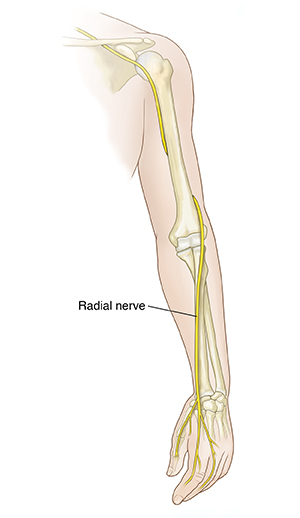Radial Nerve Palsy
The radial nerve runs down the length of the arm. It's one of the nerves that carry signals from the brain down the arm to the hand. It controls movement of the triceps muscle at the back of the upper arm. It also controls movement and feeling in the wrist and hand. Radial nerve palsy (also called wrist drop) is caused by damage to the radial nerve. Symptoms include:
-
Weakness of the wrist and fingers
-
Muscle shrinkage in the forearm
-
Pain in the arm, wrist, or hand
-
Inability to straighten the wrist or fingers
-
Numbness or tingling of the hand
Injury to the radial nerve may be caused by:
-
Direct blow to the nerve
-
Cut or other wound that affects the nerve
-
Fracture of the arm or elbow
-
Unrelieved pressure on the radial nerve (from things such as sleeping with the arm trapped under the body)
-
Injury that results in swelling around the nerve
-
Use of crutches resulting in compression of on the nerve
-
Long-term constriction of the wrist (for example, from a tight watch or bracelet)
-
Repetitive twisting motions of the forearm
In some cases, no cause can be found.
The treatment depends on the cause and location of the nerve damage. In some cases, the problem will go away on its own once pressure to the nerve is relieved. Your healthcare provider may do electromyography (EMG) and nerve conduction studies (NCS) to determine the extent of damage done to the radial nerve. This will allow your provider to know a rough estimate of the time needed for you to get better. Splinting the wrist to support the fingers and wrist will help with function. If the problem is due to trauma or injury, physical therapy may be prescribed. Depending on where the nerve is injured, corticosteroid injections into the area may reduce swelling and pressure on the nerve. Surgery to repair the nerve may be needed for chronic symptoms that don't respond to simpler treatments.

Home care
-
Take part in therapy and rest the wrist and arm, as directed by your physical therapist and healthcare provider.
-
If you were given a splint or sling, wear it as directed.
-
Don't lean on your elbows or hang your arm over the back of a chair.
-
If medicines were prescribed for pain or nerve sensations, take them as directed.
Follow-up care
Follow up with your healthcare provider or as advised by our staff.
When to get medical advice
Call your healthcare provider right away if you have any of the following:
-
Increasing arm swelling or pain
-
Worsening numbness or weakness of the arm
-
Symptoms spreading to other parts of the body
Call 911
Call 911 if any of these occur:
-
Slurred speech, confusion
-
Shortness of breath or trouble breathing
-
Trouble speaking, walking, or seeing
Online Medical Reviewer:
Joseph Campellone MD
Online Medical Reviewer:
Marianne Fraser MSN RN
Online Medical Reviewer:
Raymond Kent Turley BSN MSN RN
Date Last Reviewed:
1/1/2022
© 2000-2024 The StayWell Company, LLC. All rights reserved. This information is not intended as a substitute for professional medical care. Always follow your healthcare professional's instructions.